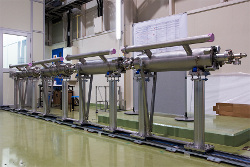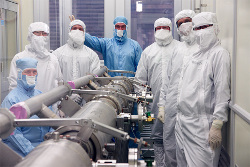 |
 |
|||||||||||||
|
|||||||||||||
|
|||||||||||||
|
Four superconducting accelerating cavities have been successfully assembled at KEK’s Superconducting RF Test Facility (STF). From 14 to 22 January, the assembly team of technical staff from DESY and Fermilab visited KEK, and completed cavity-string assembly work in the STF cleanroom, making a wonderful start for S1 global, a crucial system test towards realising the International Linear Collider. The object of S1 global is the demonstration of two connected four-cavity cryomodules operating at an average accelerating gradient of 31.5 Megavolts per metre (MV/m), the design gradient for the ILC. Each cryomodule will contain four dressed cavities stringed together, coming from around the globe; two from Europe (DESY), two from the Americas (Fermilab and the Thomas Jefferson Lab National Accelerator Facility), and four from Asia (KEK). “It went pretty well. We expected seven to eight days to get the job done. Instead, we finished faster than our initial estimated schedule in five days,” said Tug Arkan from Fermilab, who led the team. This team has already worked together in 2007, when DESY sent their "cryomodule kit" to Fermilab for the first 1.3-GHz Cryomodule (CM1) assembled in the US. DESY technical staff provided guidance to colleagues at Fermilab throughout the entire module assembly process there. “We knew each other well already, we knew how we work. That definitely helped,” said Arkan. Another important factor that bring the assembly work to success was the "communication". “We had numerous meetings prior to the actual job, because we knew that working environment at KEK would be completely different form those at Fermilab or DESY,” said Eiji Kako from KEK, who coordinated this assembly work. Kako, together with Shuichi Noguchi, went to Fermilab and to DESY with Norihito Ohuchi last September. They had intensive discussions to find out what to prepare before the assembly teams get to KEK. A series of WebEX meeting followed their Fermilab visit. “We thoroughly went over the possible scenario in Japan – what could happen, what could run short and so on – then made a careful preparation. That was the major reason why the work went so smoothly.” Arkan agrees with Kako: “During the initial meetings at FNAL and DESY, we asked our KEK colleagues what tools or fixture will be needed during the assembly, and everything we requested was there.” Before they started to work, four dressed cavities were staged on the post fixture, and the exterior surface of those cavities wiped clean by the KEK team. The team started assembly work on 15 January in a cleanroom of ISO class 6, or class 1000, where there are no more than 35200 particles per cubic metre larger than 0.5 microns in the atmosphere. Since the KEK clean room is rather compact compared to Fermilab's and DESY's cleanrooms, “it surely was a different experience working in different clean room,” said Arkan. “It was challenging, but we have enough experience to make it happen.” Not all of cavities gathered at KEK were exclusively fabricated for S1 global, and also aiming for the performance check for each cavity type, the length varied from cavity to cavity. To string those different-length cavities together, they had to adapt different size connecting components called the interconnecting bellows. After the gate valve sub-assembly, two cavities from DESY, dubbed Z109 and Z108, were connected together with interconnecting bellows. Then the US cavity, ACC011, was fixed with longer length bellows to stringed DESY cavities, followed by another US cavity, AES004. The assembled cavities were then connected with the gate valve via a transition piece to make a fully assembled four-cavity string, which successfully passed the leak check, marking a "mission accomplished" for the string assembly of cryomodule-C. Akira Yamamoto, one of the Project Managers of the Global Design Effort, said in his farewell address to DESY-Fermilab team: “It has been beautiful work, beautiful team work, and really beautiful collaboration. I confirm my belief that this will bring us a future ILC”. “But it is just a successful beginning,” said Ohuchi, who is taking over those four cavities to cold mass assembly in the following weeks. “You really don't know until you have cooled the cryomodules.” An Italian team of three from INFN and one engineer from Fermilab will come to KEK in February for cold mass assembly for Cryomodule-C, and the KEK team will start string assembly in the cleanroom for four Japanese cavities in February for Cryomodule-A. The system test is expected to start in the middle of 2010. -- Rika Takahashi |
|||||||||||||
| © International Linear Collider |

